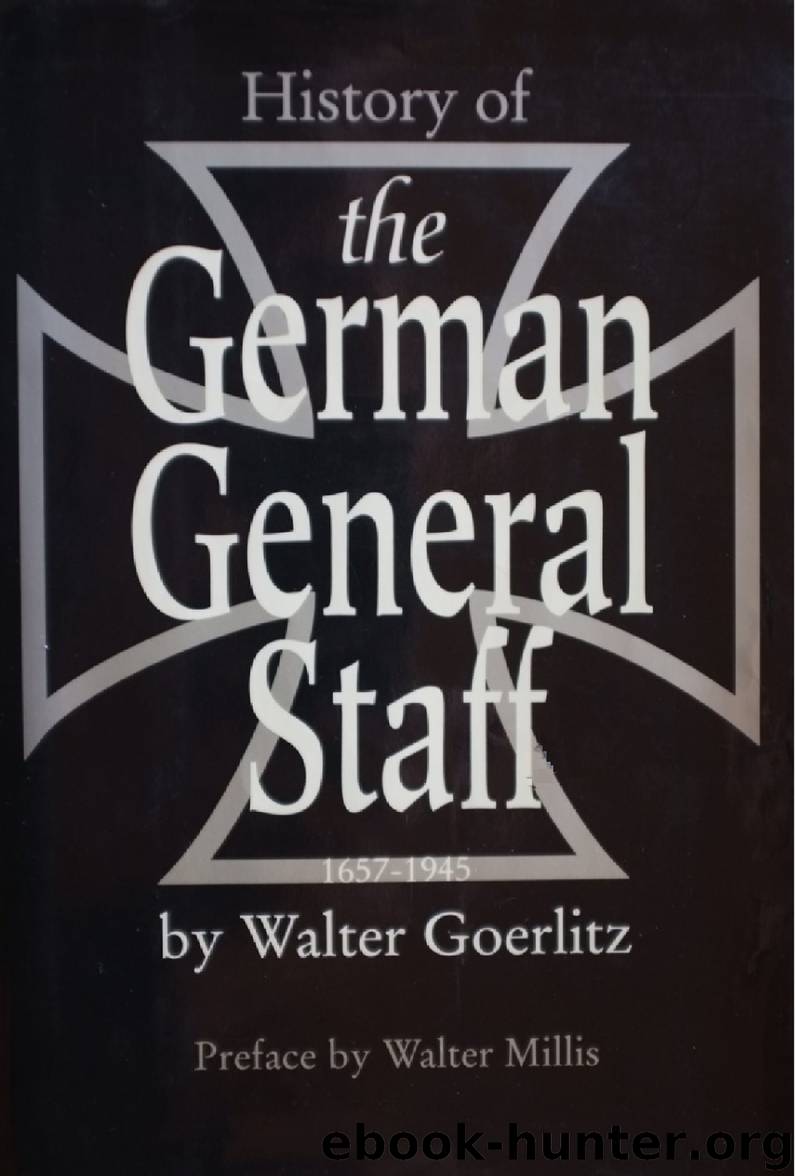History of the German General Staff 1657-1945 by Walter Görlitz

Author:Walter Görlitz
Language: eng
Format: epub
Publisher: Pickle Partners Publishing
Published: 2015-11-13T16:00:00+00:00
IV — The “black staffs” —Sabotaging the Reichstag’s Committees of Enquiry—The General Staff and industrial production—The Wirtschaftsstab—The rôle of Krupp—Camouflaged Tank production—The Navy’s secret activity—Captain Lohmann’s enterprises
The new treaty evasions were concerned primarily with the illegal increase of military effectives, with preparation for a possible mobilization and with the development of forbidden weapons such as heavy artillery and tanks (to say nothing of weapons that were entirely new) and with the creation of a secret Air Force and cognate activities on the part of the Navy.
The organization which was primarily concerned with the first of these activities, namely the problem of increasing effectives and supplying the weak regular forces with some kind of a trained reserve, was the Grenzschutz Ost, which, as we have noted, owed its origin largely to Seeckt’s own activities in 1919. The existence of this institution enjoyed the moral support even of Socialists and left-wing Catholics. Wirth repeatedly defended it, while Stresemann knew what was happening and approved it by his silence, nor had he any intention of changing his attitude so long as the Polish question remained unsolved.
The backbone of the whole system of frontier defence in the east was formed by the so-called “black staffs” who worked, ostensibly as civilians, under the eastern military district commanders, and by the Kreiskommissars, who were also supposed to be civilian functionaries and whose chief concern was the keeping of muster-rolls and the care of concealed arms. All these worked in co-operation with the Prussian governmental machine, although the Prussian government itself periodically sought to put a stop to these proceedings. Schleicher, who for a long time was concerned with the organizational direction of this frontier defence, replied to all protests with the stereotyped assurance that the measures in question were about to be discontinued—though, needless to say, they were not discontinued at all. The strength of this irregular defence force came to about 30,000 men, and to this must be added the so-called “Workers’ Associations” (generally ex-Freikorps men or members of the Stahlhelm) who guarded the arms dumps. Usually these dumps consisted of nothing more than small arms and small-arms ammunition, though in a few isolated cases some pieces of artillery and some armoured cars were also hidden away.
Further measures taken about this time dealt even more directly with the Reichswehr itself. Seeckt had on no less than three occasions drawn up lengthy memoranda emphasizing the importance of the Reichswehr’s function as a protectress of the national frontiers, and he now was quietly permitted to raise the ratio of discharges from 13 to 25 per cent, the aim again being gradually to build up a modest body of reserves. The Truppenamt during this period also acted as adviser to the Navy, which set about the illegal training of volunteers. In this case the results were not spectacular, since not more than 600 men were raised.
Schleicher took over the political end in these affairs, a task of some delicacy, for though Stresemann was content to be blind in
Download
This site does not store any files on its server. We only index and link to content provided by other sites. Please contact the content providers to delete copyright contents if any and email us, we'll remove relevant links or contents immediately.
| Automotive | Engineering |
| Transportation |
Whiskies Galore by Ian Buxton(41880)
Introduction to Aircraft Design (Cambridge Aerospace Series) by John P. Fielding(33064)
Small Unmanned Fixed-wing Aircraft Design by Andrew J. Keane Andras Sobester James P. Scanlan & András Sóbester & James P. Scanlan(32743)
Craft Beer for the Homebrewer by Michael Agnew(18140)
Turbulence by E. J. Noyes(7936)
The Complete Stick Figure Physics Tutorials by Allen Sarah(7307)
Kaplan MCAT General Chemistry Review by Kaplan(6867)
The Thirst by Nesbo Jo(6828)
Bad Blood by John Carreyrou(6552)
Modelling of Convective Heat and Mass Transfer in Rotating Flows by Igor V. Shevchuk(6391)
Learning SQL by Alan Beaulieu(6211)
Weapons of Math Destruction by Cathy O'Neil(6146)
Man-made Catastrophes and Risk Information Concealment by Dmitry Chernov & Didier Sornette(5921)
Digital Minimalism by Cal Newport;(5664)
Life 3.0: Being Human in the Age of Artificial Intelligence by Tegmark Max(5474)
iGen by Jean M. Twenge(5366)
Secrets of Antigravity Propulsion: Tesla, UFOs, and Classified Aerospace Technology by Ph.D. Paul A. Laviolette(5309)
Design of Trajectory Optimization Approach for Space Maneuver Vehicle Skip Entry Problems by Runqi Chai & Al Savvaris & Antonios Tsourdos & Senchun Chai(5011)
Pale Blue Dot by Carl Sagan(4912)
